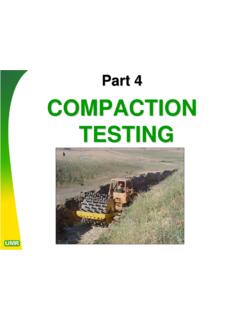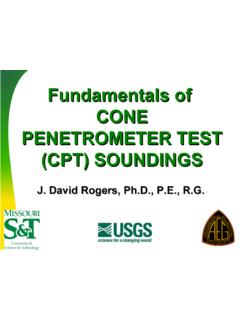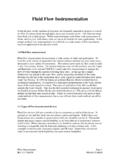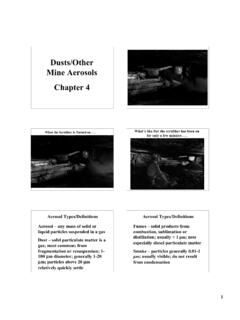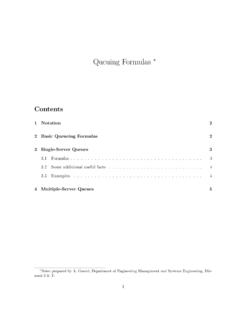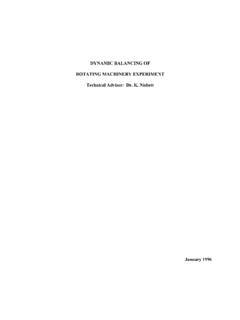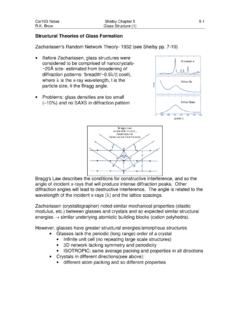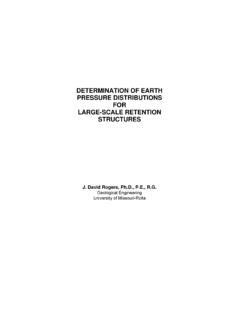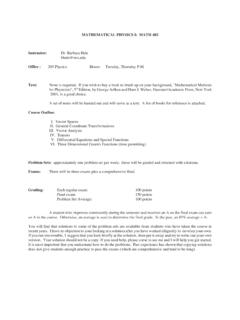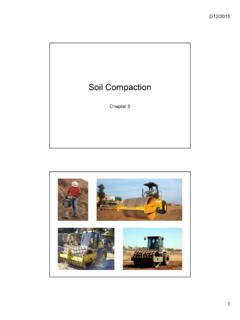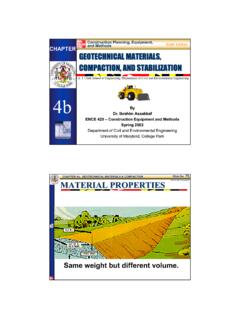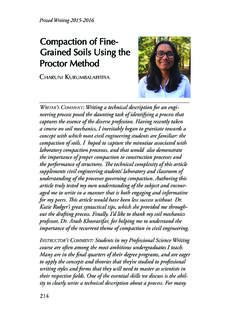Transcription of Part 3 COMPACTION TESTS - Missouri S&T
1 part 3 COMPACTION TESTS evolved to support bomber loads on runways Need to increase bearing capacity Up through the mid-1930s military aircraft were relatively light, and could be supported on natural fields with grass runways, like that shown at upper left In 1937 the Army Air Corps began flight testing new long range bombers, like the Boeing XB-15, at lower left. This aircraft had a gross takeoff weight of 71,000 lbs, spread on tandem main gear tires and a single tail wheel. It could only use select concrete runways. Prior to this time, 12,500 lbs were the heaviest wheel loads any runway had been designed to handle The Boeing XB-15 bomber at Wright Field near Dayton, Ohio in 1937 Grass runways and parking areas were common prior to 1940 because most aircraft were of relatively light weight The airfield runway crisis of 1941 The massive Douglas B-19 bomber had a wingspan of 212 feet with a maximum gross weight of 162,000 lbs, spread onto just three tires.
2 Its extreme weight engendered bearing failure of the concrete ramp at the Douglas factory in Santa Monica, forcing delays until a thicker concrete runway could be constructed. On June 27, 1941 the B-19 departed Clover Field in Santa Monica and landed at March Field near Riverside, California. Upon touchdown and taxi its massive 8-foot diameter tires inflicted noticeable damage to the taxiways and parking apron. This damage hastened an investigation by the Army Corps of Engineers, eventually leading to development of new design procedures to enhance COMPACTION of pavement subgrades, which became the Modified proctor COMPACTION Test. Most bearing capacity failures occurred on taxiways in the European Theater During World War II, the Corps of Engineers noted an increasing problem with pavement distress near the edges of heavily traveled taxiways.
3 The weak link appeared to be subgrade preparation (images from 401st Bomb Group at Deenethorpe, UK) The Corps of Engineers Airfield Pavement Design Advisory Council at the Stockton Test Track in California in 1944 Army Corps of Engineers Airfield Pavement Design Advisory Council, standing on a B-19 bomber tire at the Stockton Test Track Front row (left to right): Colonel Henry C. Wolfe (who had worked on the Fort Peck Dam soil mechanics problems), Prof. Westergaard of Harvard, and Dr. Philip C. Rutledge of Moran, proctor , Freeman & Meuser. Back row, left to right: Prof. Arthur Casagrande of Harvard, Thomas A. Middlebrooks (the Corps senior expert in soil mechanics, who had also worked on the Fort Peck Dam landslide), James L. Land of the Alabama State Highway Department, and O.
4 James Porter of the California Division of Highways, who originated the CBR test procedure, beginning in 1928. Stockton Airfield Test Track Stockton Airfield was the Corps principal test site for evaluating Pappy Porter s California Bearing Ratio (CBR) test to compare subgrade modulus with various wheel loads and repetitions, working with the California Division of Highways and the Sacramento District of the Corps of Engineers under the supervision of Porter, between 1942-45. 240,000 lb pneumatic roller used in the runway pavement TESTS at the Stockton Airfield test track Aircraft wheel loads depicted as equivalent columns of concrete, three feet in diameter (from Freeman and Porter, 1945) In 1945 the Army Corps of Engineers conducted numerous experiments with modified rollers, such as the railroad rail spike roller shown here.
5 It engendered spike pressures of 260 psi empty, and up to 1080 psi when the roller was loaded with slurry, the case shown here. These were designed to evaluate rollers exerting 250, 450, and 750 psi; a 19,500-pound wobble-wheel roller; and 10,000-, 20,000-, and 40,000-pound rubber-tired wheel loads (simulating increasingly heavy bombers). The Corps of Engineers developed flexible pavement design procedures During the Second World War (1941-45) the Army Corps of Engineers developed specialized design procedures for flexible asphalt runways that incorporated the properties of the pavement subgrade, because the aircraft wheel loads are transmitted directly to the subgrade in flexible pavements. This focused attention on the importance of subgrade COMPACTION , leading to the Modified proctor COMPACTION test in 1946.
6 These same design procedures were subsequently incorporated into post-war design of flexible asphalt highway pavements (as shown in the above chart), which Were used in the Interstate & Defense Highway Program, beginning in 1955. Simplified flexible pavement design methods had an enormous impact on highway and airfield construction during the Second World War, leading to a post-war explosion in highway construction, beginning with the first Federal Aid to Secondary (FAS) highways program in 1944. Flexible Asphalt/Concrete bituminous pavements The Big Bomber With a maximum takeoff weight of 133,500 lbs, the B-29 Superfortress bomber required new pavement design methods and construction techniques at western Pacific bases In the fall of 1944 Pappy Porter was dispatched to the Mariana Islands to troubleshoot the pavement problems Bearing failures B-29s in Pacific Theater These images show B-29 bombers on taxiways in the Mariana Islands and Iwo Jima, where an unusually high degree of pavement distress occurred because of inadequate subgrade COMPACTION .
7 The volcanic cinders at Iwo Jima proved particularly problematic, as shown below. Bearing failure ruts on Iwo Jima taxiway caused by a B-29 s tandem main landing gear Tandem main landing gear The landing gear of the B-29 spread 133,500 lbs on six tires Transient aircraft ramp at Iwo Jima, where bearing failures occurred, despite fact it was founded on 36 inches of volcanic cinder rock B-29s queuing up on a taxiway at North Field, Tinian Solving the B-29 pavement design problem focusing on subgrade COMPACTION Transient aircraft ramp at Iwo Jima, where bearing failures occurred, despite fact it was founded on more than 36 inches of volcanic cinder rock Tandem main gear tires Compacting gravel subgrade for runways Rolling crush coral pavement for B-29 runways Spreading crushed coral topping for B-29 runways Short hauls from quarry to placement on Iwo Jima By the war s end in August 1945, Yonton Field on Okinawa was being constructed with a well-graded mix of crushed coral 30 inches thick!
8 Laying and spreading 30-inch thick crushed coral topping layer in August 1945 at Yonton Field on Okinawa 54-inch thick B-29 harsdstand at North Field on Tinian Maintenance crews were kept busy repairing isolated bearing capacity failures along heavily traveled taxiways. After the Second World War, the bombers kept getting larger In 1952 the Ivy Mike hydrogen bomb was introduced, shown at left. It weighed 42,000 lbs, and the B-36 was the only aircraft that could carry it. This created another runway B-17 B-29 B-36 B-29 B-36 The massive 110-inch diameter wheels of the prototype Convair YB-36 bomber became the largest post-war pavement design problem, requiring pavement sections of 18 to 50 inches thickness, originally developed for the B-19. These subgrade materials were compacted to the new Modified proctor standard.
9 Air Force officers looking over one of the 110-inch diameter tires of the YB-36 dual-tandem, 4-wheel bogie-type landing gear One aspect of the solution was to replace the massive 110-inch tires with dual-tandem, four-wheel bogie-type undercarriage using 56-inch tires; common to virtually all heavy aircraft today An unusual tracked landing gear configuration was among the many possibilities that were tested The modified proctor basis of 1946 was developed by the US Army Corps of Engineers Waterways Experiment Station in Vicksburg. It uses the same cylindrical mold as the Standard proctors (4 in. dia and in. high, with a removable mold collar in. high). The mold volume is 1/30th cubic foot A 10 pound hammer, 2 inches in diameter, was pulled upward and allowed to free-fall 18 inches, onto the soil (15 ft-lbs per blow) The soil was compacted in five lifts, with an average thickness of inches/lift.
10 25 blows were exerted per lift, which equals 25 x 15 = 375 ft-lbs. The total input energy for the five lifts is 5 x 375 = 1875 ft-lbs on a soil sample with a volume of 1/30th cubic foot. This equals 56,250 ft-lbs of compactive energy per cubic foot of soil It was designated ASTM Test D1557 or Modified AASHTO T180, initially adopted in 1958 The Modifed proctor Test uses a 10-lb hammer in an 18-inch drop sleeve. Both the original and Modified proctor test components are shown here The Modified proctor COMPACTION Test (1946) O Hare Airport (1947-62) In 1947 the Burke Engineering Co of Chicago hired Ralph Peck and Pappy Porter to advise them on the runway designs for O Hare Airport. It was the first domestic airport runway designed using the new design methodologies, employing the Modified proctor COMPACTION test on the aggregate basecourse, but without any COMPACTION of the native subgrade (contrary to Peck and Porter s recommendations).
